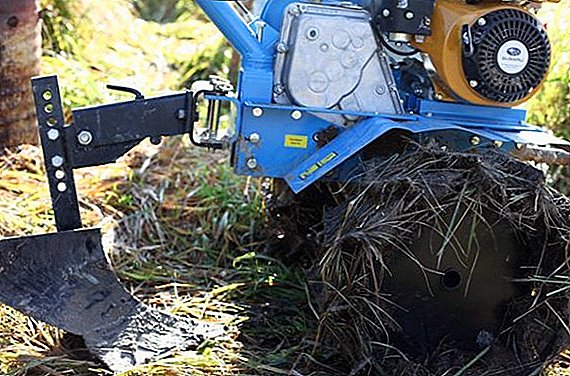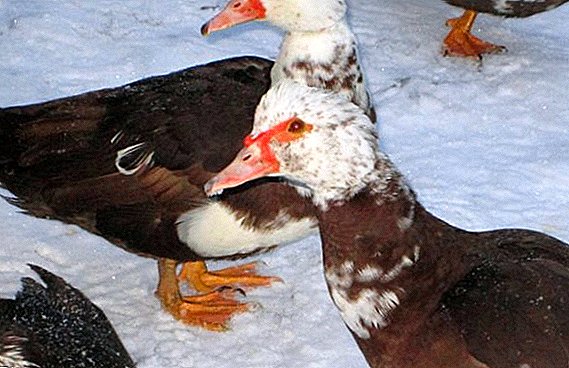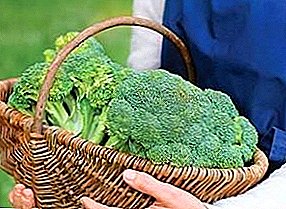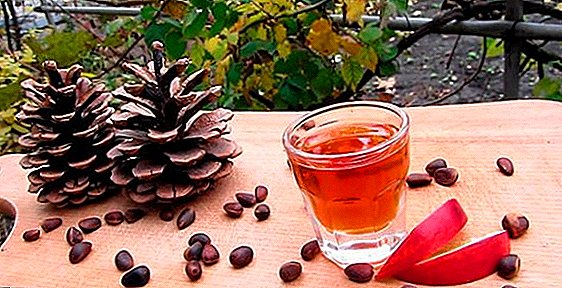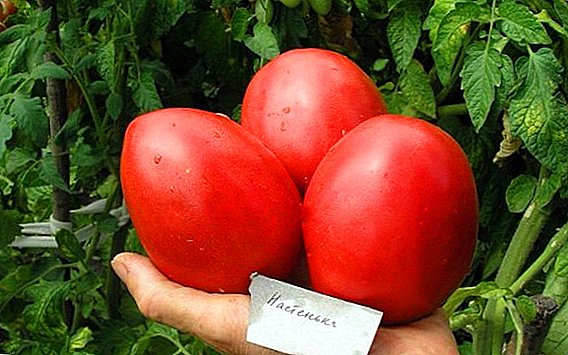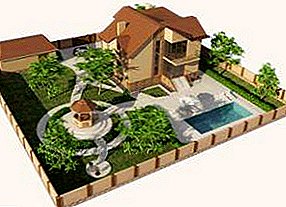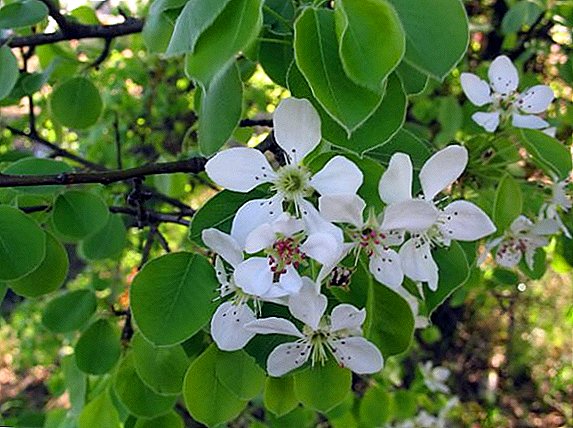 Since ancient times, pear has been the most popular fruit tree. This article will help you plant a pear of the variety "Elena" without any problems and enjoy its tasty fruits.
Since ancient times, pear has been the most popular fruit tree. This article will help you plant a pear of the variety "Elena" without any problems and enjoy its tasty fruits.
Characteristic pear varieties "Elena"
 Pear "Elena" is an early winter variety. This is a short fruit tree with a pyramidal crown. Fruits grow weighing up to 190 g, bright yellow color. The taste is sweet and sour and slightly tart. Productivity from one tree - up to 40 kg. This description of the "Elena" pear variety will help you determine whether to plant it in your own garden or not.
Pear "Elena" is an early winter variety. This is a short fruit tree with a pyramidal crown. Fruits grow weighing up to 190 g, bright yellow color. The taste is sweet and sour and slightly tart. Productivity from one tree - up to 40 kg. This description of the "Elena" pear variety will help you determine whether to plant it in your own garden or not.
Did you know? The ancient Greeks escaped from motion sickness during sea crossings with the help of pears. They continuously absorbed the pieces of these juicy fruits, and the manifestations of motion sickness decreased.
It is also important to say about pear pollinators. There are several varieties of fruit tree that need to plant other varieties in the neighborhood. They will pollinate them.
Pear "Elena" does not need pollinators. This property is called self-fertility. Thus, this variety independently sets fruit.
Advantages and disadvantages of the variety
Like all plants, the pear variety "Elena" has its advantages and disadvantages.
Advantages:
- Excellent taste of the fruit;
- Resistance to frost;
- High yield;
- Resistance to fungal diseases;
- Resistance to scab;
- The appearance of the fruit;
- Stored in the refrigerator for up to four months;
- Winter ripening.

The disadvantages of this variety are minor:
- With a bountiful harvest, the fruits are not one-dimensional;
- Average winter hardiness.
Did you know? The Chinese, saying "fen li", mean one of two things: part or share a pear. Therefore, the ancient Chinese superstition says that you can not share a pear, otherwise separation is inevitable.
Features planting pear varieties "Elena"
When to plant
Pear "Elena" planted either in autumn or spring. It should be borne in mind that the autumn planting is carried out in the first half of October, before the start of frost, and spring falls at the end of April, when the frosts have passed.
 It makes sense to clarify that for the southern regions of the country the autumn planting is beneficial because the sapling may not take root in the hot summer. In the northern regions should plant a pear in the spring, as in the frosty winter the plant will die.
It makes sense to clarify that for the southern regions of the country the autumn planting is beneficial because the sapling may not take root in the hot summer. In the northern regions should plant a pear in the spring, as in the frosty winter the plant will die.
How to choose and prepare a place under the pear "Elena"
Before planting, choose a place for the pear. It should be sunny, but not hot, while it must be borne in mind that the air saturated with water vapor will have a bad effect on the plant and it will begin to wither. In the garden, the pear should be planted either on the south, or south-west, or west side.
Groundwater should not be above two meters. The clayy dense soil will not work for the pear "Elena", since it does not tolerate excess moisture.
We decided that he likes pear, so we turn to the preparation of the site for planting.
Pit begin to engage in the fall, even if they decided to plant a pear in the spring. This is due to the fact that during the winter time the hole will settle, and after planting it will not be necessary to worry about the "shrinkage" of the soil.
Important! Depthing the root neck of a pear tree is destructive.
 If you decide to plant a pear in the fall, you should prepare the ground a week before planting. The depth of the hole depends on the roots of the seedling. It should be 50 cm, and about a meter wide.
If you decide to plant a pear in the fall, you should prepare the ground a week before planting. The depth of the hole depends on the roots of the seedling. It should be 50 cm, and about a meter wide.
You can also dig a hole deeper. This is done in order to fill the pit with 3 cm of fertile soil, which will be mixed either with humus, or peat, or with superphosphate.
Important! Avoid nitrogen fertilizers, it can badly affect the fruit tree.
A peg is driven into the center of the pit, since the pear can be deformed without a garter. The bottom of the pit is loosened, and holes are made on the walls of the hole, which will improve air exchange and will stimulate the growth of the root system.
Step-by-step process of planting seedlings
Now it is necessary to tell about planting a seedling in the hole. 
- It is necessary to carry out preparation of a sapling. The tree pruned thick and powerful roots up to 12 cm and completely cut off the top. Now that the sapling is a straight stick, it should be placed in a bucket of water for an hour.
- The dug earth from the pit is mixed with ash in proportions of 1: 1 and diluted with water. The consistency of the mixture should be similar to a very thick sour cream. Dip the seedling roots in this mixture.
- Loosen the earth at the bottom of the hole and lay ten raw eggs on the bottom. Then fill the pit with a mixture of earth and ash and sprinkle it with dry soil.
- We plant a sapling. It is important to take into account that the root neck is at the level of the upper layer of soil. You can put a bar on the bottom of the pit or make a mark on the peg. This will help to establish the seedling correctly, without having deepened the root neck.
- After all, we fill the pit with earth so that the tree is stable. We place dozens of eggs along the perimeter. After this, the pit is covered with earth "with a mound". This hill will settle after watering.
- Cut the tops of the top with garden pitch or a mixture of earth and ash.
- The barrel is tied to a peg, but not dragging.
- Planted pear pour over two buckets of water.
- Pristvolny circle is mulched with peat, sawdust, compost or paper.
Important! Whole eggs can be replaced with egg shells.
Features care for pear varieties "Elena"
After planting pears should ensure proper care of the tree. After all, this is a guarantee of a good harvest.
How to water the pears
 As mentioned earlier, the tree loves moisture, so you should think about a system of watering pears, "Helena". Best - sprinkling. So water enters the whole plant through numerous small holes.
As mentioned earlier, the tree loves moisture, so you should think about a system of watering pears, "Helena". Best - sprinkling. So water enters the whole plant through numerous small holes.
You can also make a small 12-centimeter ditch around the pear. Watering should be carried out several times in summer and spring. In case of heat, it is necessary to water the pear more often.
The main thing is to remember that the tree needs good watering, but you should also not forget about the winter hardiness of the pear "Elena". If the plant did not receive the right amount of moisture in the summer and gave a good harvest, it means that the plant is depleted. These trees are less resistant to frost.
Did you know? Surprisingly, a soft, juicy and sweet pear helps to make your teeth stronger. It's all about microelements. Pear contains natural calcium and phosphorus, which, acting together, strengthen tooth enamel.
When and how to feed
 Top dressing is one of the main steps towards the high fecundity of the Helena pear.
Top dressing is one of the main steps towards the high fecundity of the Helena pear.
In order to determine what you need to feed the tree, you can look at its appearance.
- If pear leaves look underdeveloped, it means that the plant lacks nitrogen;
- Poor aging and a decrease in frost resistance is a sign of excess nitrogen;
- The fall of the shoots in the lower part of the tree and the retention of bud buds is a lack of phosphorus.
- The brown color of the leaves and their quick drying are signs of potassium deficiency;
- If leafing appears on the leaves, which leads to the death of these areas, it is a lack of calcium.
Important! Fertilize the fruit tree is needed if it grows on fertile soil.
The depletion of even the most nutrient rich soil can affect fructification and vitality. For recovery use different means depending on the type of pear.
Some gardeners contribute nutrients in the fall. This allows you to prepare a pear for the winter and provide the soil with all the nutrients for the winter period. Conduct autumn dressing after harvest.
 Other gardeners apply fertilizer in spring. This feeding is aimed at normal restoration of the tree from hibernation.
Other gardeners apply fertilizer in spring. This feeding is aimed at normal restoration of the tree from hibernation.
It can calmly prepare for the growing season. It also helps to improve the quality of the future harvest.
Did you know? One pear contains 20% of the daily requirement of fiber, 10% of vitamin C and 6% of potassium.
In order to determine the type of fertilizer, you should rely on the following parameters:
- Age;
- Appearance;
- Season;
- Soil type
You should also not forget about foliar feeding. Fertilizer is a solution of nutrients. It consists of a 2% solution of potassium sulfate.
Urea solution should be sprayed pear 10 days after completion of flowering. Spray again after two weeks.
 You can use complex feedings, for example, ammophos, nitrophos, nitrophoska and nitroammophos.
You can use complex feedings, for example, ammophos, nitrophos, nitrophoska and nitroammophos.
In addition to the macro-fertilizers need to make micronutrient fertilizers. With their help, the soil is enriched with iron, manganese, zinc, etc. Choose them based on the composition of the soil.
You can make manure that contains phosphorus, nitrogen and potassium.
Important! Be careful with organic matter, as it can lead to severe wood burns.
When and how to prune pears
Pruning pear "Elena" is carried out in spring, summer and winter. This procedure improves the quality of the fruit, regulates the fruiting and growth of the tree, improves the lighting of the leaves. Pruning helps to grow the tree you need growth with a strong trunk that can withstand a large crop weight.
Spring pruning is carried out after severe frosts.
Trimming rules
- Use a sharp blade pruner for this procedure. For large trees need to take a hacksaw. After cutting, all garden tools are disinfected with alcohol.
- The central trunk is shortened by one fourth. This will allow to form a pear shaped cup in the future.
- Trimming is carried out at a temperature not lower than 5 ° С .
- After the procedure, the slices are smeared with the following mixture: linseed oil, oil paint, garden pitch and Rannet.

There are two ways to trim. First: cut down at the base of the branch. So that the bark does not bully, the cut is done at the bottom, and then the main upper gash. This ensures the acceleration of the growth of lateral shoots and the awakening of the buds that are below the cuts. Before spring pruning, it is forbidden to use nitrogen fertilizers.
The correct cutting of a tree will allow a pear to begin to give a rich harvest, and all places of cuts will grow.
Summer pruning is a kind of nip. In summer, growing shoots are removed on tree tops.
Now it is important to consider when to pinch and what will be the reaction of the pear:
- Pinching in june. Such pruning leads to a delay in the growth of shoots, but it contributes to new formations. It is important to remember that pinching badly affects the growing season of pears, and this affects the wintering.
- Pinching at the end of growth attenuation. It improves the maturation of the shoots.
Such pruning is carried out from the beginning of November to March, because at this time the tree is at rest. Such pruning is done with a pruner. Removed cross, weak, dead branches.
For cutting large branches you need to open the middle of the tree. Winter pruning is needed only if you want to remove the height of the tree and remove the spreading branches. To ensure that the slices heal faster and do not freeze in winter, use a sterile pruner and, after pruning, treat the slices with a garden pitch.
Did you know? In Europe, pear leaves were smoked, and only then came tobacco.
When to harvest and how to store the harvest pear varieties 'Elena'
Many gardeners use the following characteristics to begin harvesting pear fruit:
- Skin color;
- Fetal attachment strength;
- The color, taste and flavor of the pulp.
Harvest pears "Elena" is down to October. So, starting from this month, you can begin to check the pears for ripening and harvest.
After you have collected the pears, they should be placed in a dark and cool place for ripening. Such a place must be pre-sanitized and ventilated.
 In this room you need to keep the optimum temperature and humidity. In winter, the temperature should be up to 3 ° C, and the humidity of the room - 85%.
In this room you need to keep the optimum temperature and humidity. In winter, the temperature should be up to 3 ° C, and the humidity of the room - 85%.
Excessive moisture or high temperatures cause the pears to rot quickly. If the temperature is low and the air is dry, the pears shrink and lose their juiciness.
Pears should be placed in special boxes, as storage on the floor leads to rotting. Boxes should be well ventilated. In winter, you need to prepare shelves. Pears are laid on them tails up and sprinkled with chips.
Important! Do not place other fruit crops near pears.
Remove spoiled and rotten pears.
The resistance of pear varieties "Elena" to diseases and pests
Pear "Elena" is resistant to various fungal diseases, especially scab or Septoria.
Diseases
- Black cancer (infects leaves and fruits, sometimes the cortex itself, which is a dangerous form);
- Fruit rot (manifests itself in the form of rot on the fruit, it spreads very quickly).
Pests
- Aphid (leads to the deformation of the leaves and their rapid extinction);
- Pear moth (reduces the level of development of the entire tree and eats the pulp of the pear from the inside);
- Pear mite (leaves turn brown, crack and die).
Control measures
- Black cancer In early spring, whitewash the stump. Spray the affected leaves with Bordeaux liquid. Destroy fallen leaves and rotten fruits.
- Fruit rot. Double pruning with the removal of drying and dead branches and rotten fruit.
- Green aphids. You can apply the ash and soap sprays. 300 g of ash is boiled in 10 liters of water and 40-50 g of soap are added.
- Pear moth. Loosen between rows and tree circles. Do it in spring and summer. Pheromone traps can also be used. Regular pruning of shoots. Insecticides can also be used.
- Pear mite Collect fallen and damaged leaves and burn. It is possible to apply spraying - 0,2% Decis and Inta-Vir.
Did you know? In the 18th century, the pear was also called “oily fruit” due to its soft, oily texture.
Pear Helena has more positive qualities than negative ones. Therefore, if you want to enjoy the juicy fruits of the fruit closer to the New Year, it is created for you.



